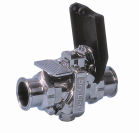| |

Click on picture above for a closer look (723px x 682px)
|
Dry Link sanitary couplings are the only true sanitary, drip-free
couplings available today because of their simple butterfly design.
The smooth mirror-polished bore has no voids, dead spaces, crevices,
or fillers that could trap bacteria. Easily drainable and sanitized
using steam or other methods such as CIP, SIP, etc, our sanitary
couplings are routinely specified in pharmaceutical, biotech, semiconductor,
food, and cosmetic industries where ultra cleanliness is required.
Sanitary couplings are usually specified with wetted internal
components polished to 20 RA micro-inch mirror finish, although
we also offer unpolished internals at economy prices. Wide choice
of sizes, body & seal materials, end connections and with full material
test certifications (MTR), FDA & USP certifications are available.
Other options such as extra fine inside polish, electro-polish,
and outside polish to matte finish.
Beware! There are many so called “sanitary”
dry-disconnect (dry-break) couplings on the market today. But
most of them are based on poppet valve or ball valve designs. By
nature, these couplings are not sanitary because they can trap
liquid and allow bacteria to germinate. A poppet valve will
always contain a dead volume of liquid, no matter what, and a
ball valve design allows a dead space around the ball and the
body. In the ball valve design, some manufacturers have
attempted to eliminate the dead space by inserting plastic shims
(PTFE fillers) around the ball. The problem with fillers is that
you cannot be 100% sure if you have completely filled in the
dead space. It would be impossible to determine the exact
thickness required for the filler because of variations in the
cast body and ball dimensions. If you assemble the body using a
slightly thicker filler, the coupling will jam and make it
impossible to turn the handle. If the filler is slightly
thinner, then certainly there would be a small void around the
ball – enough for the liquid to seep into the void and create a
dead volume for bacteria to germinate.
|